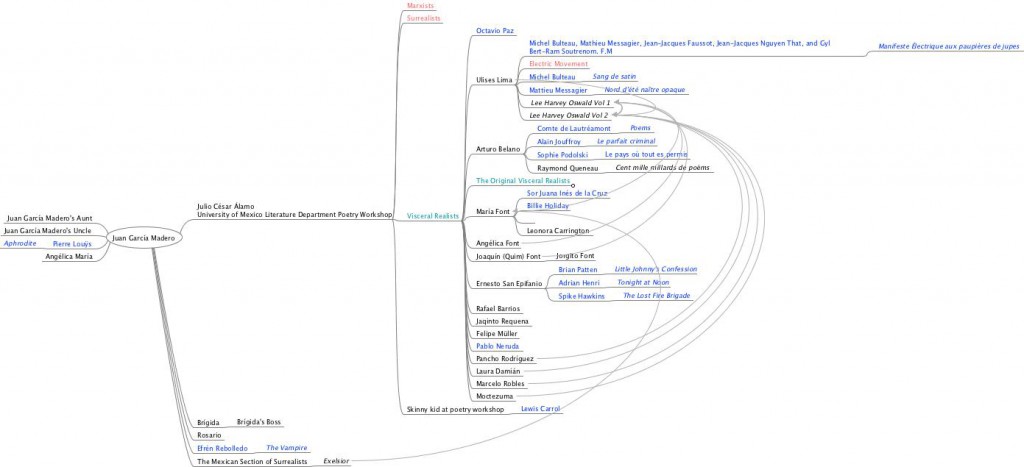Bootcamp: Intertextual and Character Contact Network Diagram: Los Detectives Salvajes
Branching out from of my first probe, I decided to take another crack at exploring intertextual networks. This time my (more focused) plan was to create a network diagram visualizing each of Juan García Madero’s contacts with fictional and non-fictional characters and texts in the opening section of Roberto Bolano’s Los Detectives Salvajes (1998). My goal was to see what type of intertextual network was created, and what type of analysis could be drawn from this network. For the sake of brevity, I limited my project to the first 30 pages of the novel.
My first attempt to draw a network diagram enabled me to visualize Juan García Madero’s contact information, but does not adequately represent the significance of these relations. For instance, in this diagram, Julio César Álamo appears to be a central figure in the text, when in reality, he is only the bottleneck that connects Juan García Madero to the Visceral Realists that the the novel revolves around. Worse than Moretti’s difficulty distinguishing between Hamlet’s significant and insignificant contacts, this diagram branches out chronologically and seems to suggest that characters meet only through the historically defined branching system. Thus, it appears that the Fonts, for instance, are linked to Madero through the Visceral Realists, which is correct, but also from the Visceral Realists through Álamo’s poetry workshop, which is not the case at all. We can follow the connections branching away from Madero, but we cannot always follow them back. The shortcoming of this failed network diagram comes from my decision to create branches chronologically as new contacts appeared as I read the text. I tried to fix this mishap by assigning arrows, which was helpful to distinguish previously unconnected lateral relations, but the connections still don’t work backwards, and as such, some parts of the diagram represent a chronological genealogy instead of a network. For this reason, it is a failed network diagram.
Legend: Blue (real author), Blue Italic (real text) Red (real Conceptual Group), Cyan (fictional conceptual Group)
My second attempt is more successful. Instead of branching out chronologically, I branch out from direct points of contact. So, if a character has direct contact with Madero, he/she has a direct line representing that contact node. If Madero discusses a text/author, it has a direct contact node as well, but if he has indirect contact with a text or author, it is only accessible in the diagram through the character that discusses the text/author with Madero. In this way we differentiate between the characters/texts/authors that influence Madero directly and indirectly. The successful aspect of diagram is that we can quantify and differentiate 100% of the intratextual and fictional contacts Madero makes in the first 30 pages. The failed aspect, however, is that i still haven’t provided a method of allotting significance pertaining to each node, and as such contact by proximity (skinny kid at the poetry workshop) is indistinguishable from Madero’s acquaintance with Lima or Belano (the novels two main characters). Some solutions to this problem are quantifiable and do not need interpretation. One example would be differentiating by line size the amount of contacts between each contact.

Despite the first failed project, and the obvious drawbacks of the second diagram, I am glad that I took the time to work through this process. Pragmatically, the MindMap software was fairly intuitive, and I can imagine using it in the future for similar projects. On a theoretical level, the project itself was also worth engaging, because it enabled me to visualize the text’s intertextual references. With more time, more references or additional information could be added, making this endeavour more interesting, and opening it up to new types of analysis. Some basic examples are dates and nationalities of the intertextual references. However, because this specific novel is so massive and contains so many references, a complete network diagram may very well be completely inaccessible. A searchable database program would probably provide a more effective avenue for objective and/or quantitative analysis of the text as a whole.
